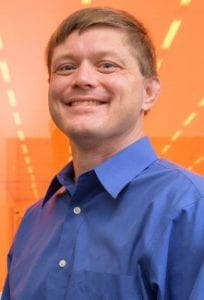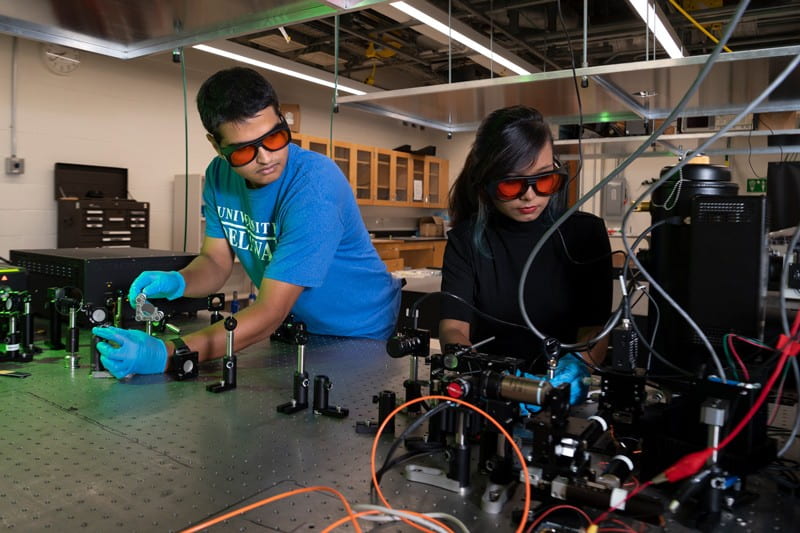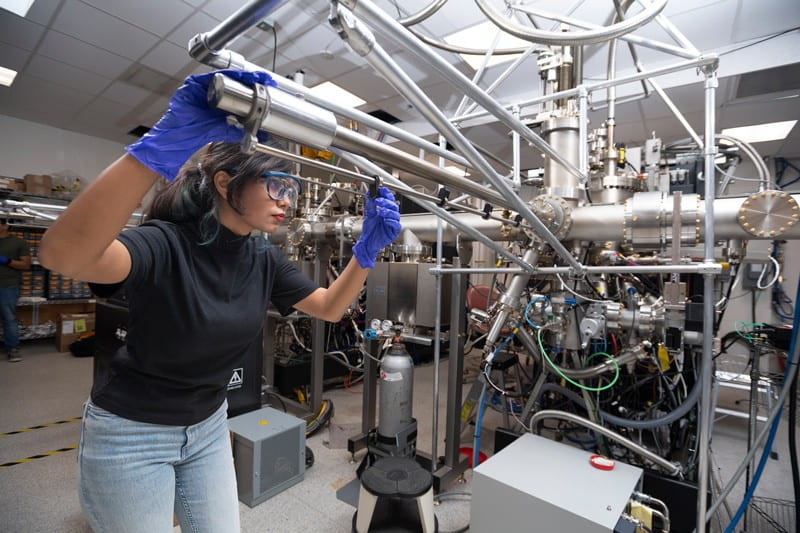UD to help advance quantum technologies, workforce development
The science of the small — quantum science and the skillful manipulation of particles as tiny as a single atom or a single photon of light — is driving a big technology revolution. Nazifa Tasnim Arony, a doctoral student at the University of Delaware, wants to be part of it.
“I’ve always been fascinated by the complex and mysterious field of quantum science,” said Arony, who is from Rajshahi, Bangladesh.
Arony is in the second year of her doctoral program in UD’s Department of Materials Science and Engineering, and she is preparing for a career in industry developing new kinds of materials for quantum technologies. They might wind up in any number of next-generation electronics, from powerful quantum computers, which companies like IBM, Intel, Microsoft and Google are racing to innovate, to exquisitely fine sensors for detecting molecules of cancer or other diseases in human cells.
The University of Delaware is on the leading edge of this tech transformation, having recently launched one of the first interdisciplinary graduate degree programs in quantum science and engineering in the United States — offering both master of science and doctoral degrees. Now, UD will assist the University of New Mexico in establishing a similar program, thanks to a significant funding award from the National Science Foundation.
The $4 million grant, from NSF’s Established Program to Stimulate Competitive Research, will bring together researchers from both universities to lay the foundation for quantum photonic technologies that are essential to building quantum computers and other devices.
Ganesh Balakrishnan, professor of electrical and computer engineering at the University of New Mexico and director of New Mexico EPSCoR, serves as principal investigator on the grant. Matthew Doty, professor of materials science and engineering and director of UD’s Quantum Science and Engineering program, will lead UD’s side of the collaboration.

Matt Doty is a professor of materials science and engineering and director of UD’s Quantum Science and Engineering program.
“Although quantum technologies are in their infancy, it is already clear we are at the start of a technological revolution that could be as big as the invention of the transistor and the advent of digital electronics,” Doty said. “What has also become clear is that the national workforce needed to drive this revolution requires different skills and training than provided by traditional disciplinary degree programs.”
The curriculum and training program for UD’s new interdisciplinary graduate degree program in quantum science and engineering was designed in close collaboration with companies like IBM, Microsoft, HRL and Northrop Grumman to develop the quantum workforce they need, Doty said.
“We look forward to partnering with the University of New Mexico on research to develop the materials fundamental to quantum photonics technologies and on our academic programs to prepare this highly skilled workforce,” Doty said. “We’re laying the foundation for the quantum revolution in terms of both technology and people.”
Lighting the way
The quantum computing market is projected to grow from $486 million in 2021 to $3.2 billion in 2028, according to Fortune Business Insights. That’s a combined annual growth rate of nearly 31% over the next six years. But what is so appealing and different about quantum technologies? They promise revolutionary advances in computation, communication, cybersecurity and sensing. But how?
Today’s digital electronics are based on bits, the smallest units of data a computer can process and store. A classical bit can have only one of two states: zero or one.
Quantum systems, however, are based on fundamental information units called quantum bits, or qubits (pronounced “cue-bits”). A qubit has the same states as a bit (zero or 1), but with an unusual bonus. A qubit can be put into a “superposition,” where it is simultaneously in both states (zero and 1). When qubits interact, a kind of multiplier effect can be achieved through “entanglement,” which means the state of one qubit is contingent on the state of another. Quantum computers designed to leverage superpositions and entanglement can outperform traditional (classical) computers because they effectively compute, in one calculation, results for many possible inputs — results that a classical computer would have to generate one at a time.

Aqiq Ishraq (left) and Nazifa Tasnim Arony align the laser for the scanning fluorescent confocal microscope in the University of Delaware’s Shared Optics Labs. The microscope is used to measure the emission of single photons from materials developed in the lab.
As this new EPSCoR grant gets underway, quantum computers are already being built. But these are the early days, and the technology has many unknowns and unique demands. There is a 65-bit quantum computer at IBM now, and the company has announced plans to put a 100-qubit computer into operation by 2023. However, Doty said, this computer can only work at extremely cold temperatures (-273° Celsius) and there are many challenges to scaling up the number of qubits on a chip.
Light is a key element in increasing the scale of quantum technologies for commercial production because single particles of light (photons) can transmit quantum information between qubits on a chip or between different quantum devices, effectively creating the “quantum internet.”
Through the NSF grant, the research team will develop materials and methods to create manufacturing platforms for the production of quantum photonic emitters. These LED-like devices can generate single photons or receive a photon and store the quantum information for future use. The emitters need to have predictable and reliable properties, their location on a microchip needs to be precisely controlled to enable their integration with potentially thousands of other qubits on a chip, and the materials and devices need to be designed in a way that can be scaled up for industry use. For the next four years, the team will be working on these challenges.
For students interested in taking a quantum leap into the future, there are endless questions to explore and paths to forge: How exactly do you make a quantum device? How do you tune its performance? And how do you create the new infrastructure needed to build and maintain quantum systems?
UD’s curriculum in quantum science and engineering is designed to rapidly introduce students to the fundamental concepts of quantum mechanics and quantum information processing, establish a shared vocabulary and knowledge base that accelerates collaboration across disciplines, and train students with the professional skills they need when they join the workforce. With a curriculum developed to maximize hands-on, project-based learning, students will be trained to use state-of-the-art equipment ranging from semiconductor nanofabrication tools to high-performance computers. Students will work in such UD research and teaching facilities as the Nanofabrication Facility, the Keck Center for Advanced Microscopy and Microanalysis, the Advanced Materials Characterization Laboratory, the Materials Growth Facility and the Nanofabrication Teaching Laboratory.
For her part in the research, Arony will be busy with experiments in the Materials Growth Facility, laying down streams of atoms from various compounds, layer by layer, using molecular beam epitaxy.
“It’s slower than grass growing,” Doty said, “but it allows for extraordinarily pure materials with control over exactly what type of atom is present in each layer, which is essential for creating the desired optical properties in our quantum emitters.”

